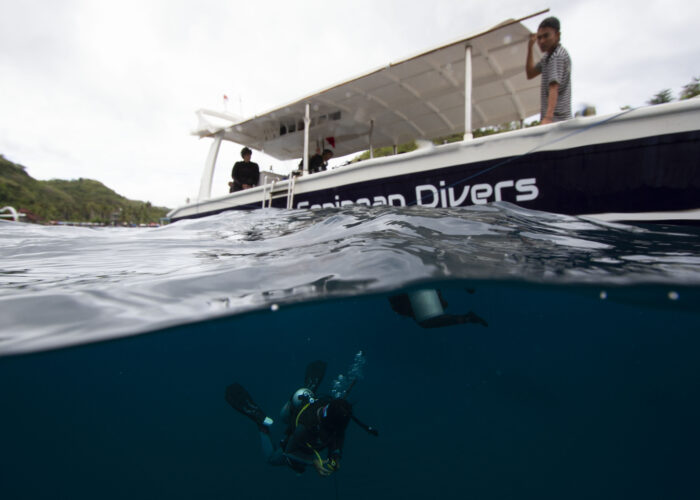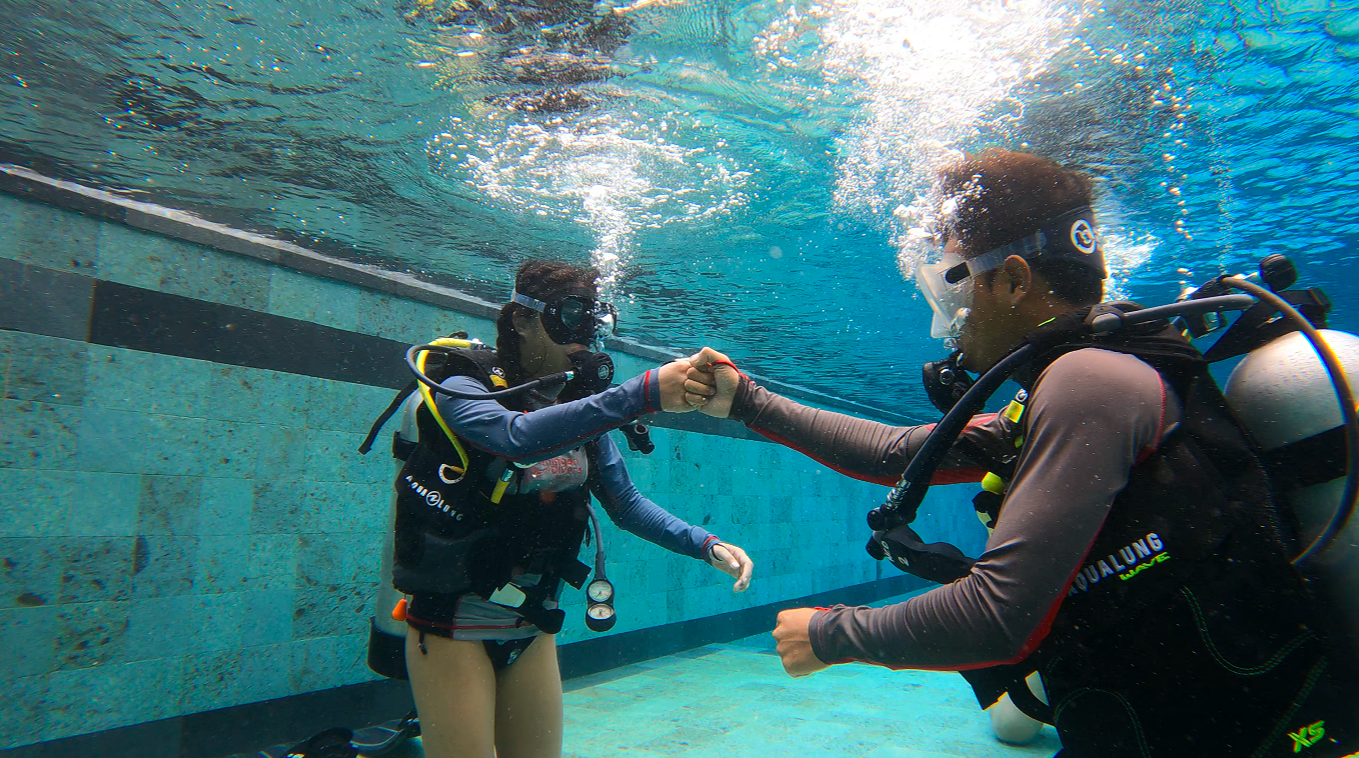One of the main reasons divers flock to the Nusa Islands is for the rare opportunity to swim alongside the Mola, also known as the Ocean Sunfish. Although they can be found in oceans around the world, there are only a handful of dive sites that they predictably visit each season. For anyone keen on seeing a Mola while visiting the Nusa Islands, it is well worth taking the time to learn a bit about these mysterious giants.
Mola by any other name…
One of the most perplexing aspects of Mola is the multitude of names that they go by. Few people realize that there are actually 5 different species of sunfish found worldwide, all under the same family, Molidae:
- Mola mola – Oceanic Sunfish, the most common and one of the largest. The most likely to be spotted around Nusa Penida.
2. Mola alexandrini – Bumphead Sunfish, similar to the oceanic sunfish but featuring large bumps on its head and chin. The largest sunfish on record was of this species. PHOTO credit: Ola Norman
3. Mola tecta – Hoodwinker Sunfish, aptly named as it was only discovered in 2017. For the longest time, it was mistaken for a Mola mola but only recently received its own species designation. PHOTO credit: Alex Hearn
4. Masturus lanceolatus – Sharptail Mola, as the name suggests, possesses a sharp tail projection, not unlike that of a giant tadpole. PHOTO credit: H. Sugiyama
5. Ranzania laevis – Slender Sunfish, the smallest (and arguably, cutest). PHOTO credit: Tobias Bernhard / Minden Pictures
The genus Mola was named purposefully, as Mola in Latin means millstone. Since none of us grew up in medieval times, it’s likely you are not familiar with this term. Millstones are basically large circular stones used to grind down grains, seeds, etc. So, you can easily see how the comparison was drawn.
Millstone, credit: Roger Griffth
The common names for these fish vary widely and generally describe the appearance or behaviour of the fish. Sunfish was attributed due to their tendency to float on the ocean surface, sunning themselves. In german their name translates to “swimming head”, and many languages refer to them as ‘moonfish’ due to their grey circular shape and splotches that resemble craters. Thankfully, the most common Mola, the “Mola mola” is easy to remember since that is literally just the genus and species of those individuals.
Sunning Mola, Credit: Paul Nicklen Photography
Anatomical Anomalies
The sunfish is the largest bony fish in the world. It’s important to note that although there are larger fish, they are cartilaginous fish, which, as I’m sure you’ve guessed have skeletons made of cartilage and not bone (eg. sharks). The Sunfish can grow to be over 3 meters tall, from the top of their dorsal fin to the bottom of their anal fins. They can also weigh over 1,000 kg, with the largest ever recorded being a Bumphead Sunfish weighing in at a whopping 2,300 kg! A notable absence is the missing caudal or tail fin, which instead has been replaced with a ‘clavus’, which is basically an extension of their dorsal and anal fins, joining together on their rear. The sole purpose of the clavus is to help steer the large disk of a fish around and make it look like it has a bum. Another strange missing feature is a swim bladder, which normally helps fish to ascend and descend in the water column. Instead, the sunfish depends on the strong fin propulsion and gelatinous body tissue which keeps it neutrally buoyant.
A Social Creature
Sunfish cleaning, credit: Jordi Chias Pujol
Since the sunfish are slow moving and will spend time at depth, they rely on other animals to help keep them free from parasites. Sunfish come to the surface and reef edges to be cleaned by birds and other fish, such as bannerfish. While diving around Nusa Penida during the dry season, it is not uncommon to see schools of bannerfish waiting at the edge of reefs only to be met by a sunfish in need of cleaning. In captivity, rescued sunfish adapt quite easily and have quickly adapted to being hand fed by aquarium staff.
Growing into Giants
The lifecycle of sunfish is a bit of a mystery. There is always new research being conducted to understand how sunfish develop and hopefully, more information will come out of these studies. Sunfish lay eggs in the open ocean, and the larvae that hatch out are mere millimetres in size. The young larvae do not resemble their enormous kin, but in fact look very much like miniature pufferfish or porcupinefish, which isn’t too surprising since they are in the same order, Tetraodontiformes.
Baby Sunfish, credit: Museum of Comparative Zoology, Harvard University
Although they start life on a tiny scale, it doesn’t take long for a sunfish to reach gargantuan sizes. According to growth analysis, sunfish will grow 60 million times in size once mature! It is not entirely clear what the lifespan of a sunfish is, but in captivity, they live for around 10 years, while it’s estimated that they can live up to 100 years in the wild.
In order to reach these sizes, sunfish need to eat…a lot. Not considered a particularly agile predator, a sunfish’s diet is primarily jellyfish, small soft-bodied invertebrates like siphonophores, squids and crustaceans. They have large fused teeth that form a beak, and a secondary set of jaws inside their mouths with multiple sharp teeth that help them to shred food. When eating, sunfish will suck and blow prey in and out of their mouths until they are shredded into more manageable pieces. It’s believed that they are able to tolerate eating jellyfish due to a protective mucous layer in their throats.
Picked off as Prey
Mola vs Sea Lion, credit: Ralph Pace
With such a large size and slow movements, it’s not surprising that sunfish are preyed on by the likes of orcas, sea lions and sharks. Sea lions have even been known to chew off all of their fins as a snack, leaving the helpless sunfish to die a slow, tragic death.
They are also known to be eaten as a delicacy in countries like Japan, South Korea and Taiwan. There is even a market for medicinal products made from sunfish in the Chinese market.
Mapping out Mola
Although sunfish have distribution among most of the oceans worldwide, they tend to spend more time in the deeper, colder waters where few have the opportunity to encounter them. The two top locations to dive with Oceanic Sunfish are in Bali and the Galapagos. It’s believed that these locations are sites which facilitate the upwelling of colder, nutrient dense waters which the mola normally inhabit. This also brings their main prey, jellyfish closer to the surface and they are nomadically tied to their food source.
Dive sites surrounding Nusa Lembongan, Nusa Ceningan and Nusa Penida, are excellent for spotting the Mola and the best season to visit is during the dry seasons from around mid-June to mid-October. This is when the water is cooler and the Molas come from below to the cleaning stations to rid themselves of parasites. Although it can’t be guaranteed that Molas will be encountered on a dive, our team is familiar with the sites they visit most and the signs that indicate Mola are present. Within that period, July and August are the more consistent months for Mola sightings. It is important to note that although they do come shallower, they are still generally found within the 18 – 40m range.
In order to ensure that we have minimal impact on normal Mola behaviour, there are regulations in place for any diver that encounters these gentle giants. These guidelines were developed by experts in Mola behaviour and research, and dive professionals to ensure the safety of the animals while also maintaining the cleaning stations for future encounters.
Code of Conduct for Sunfish Interaction
- Always approach sunfish slowly and within its field of view
- If the fish is within a cleaning station, do not approach until it has been stationary for at least 1 minute of cleaning. Make sure to maintain a distance of 3 m from these stations.
- When the sunfish is freely swimming, maintain a distance of 10m.
- Never touch or feed a sunfish, they have a protective mucous layer on their skin that helps keep them safe from parasites.
- Do not swim behind the sunfish as this can startle them.
- Do not swim under the sunfish as the bubbles can disrupt cleaning.
- Do not block a sunfish from an escape route or path to a cleaning station.
- Do not use flash photography as it often disturbs the fish.
- Do not make unnecessarily loud noises or use motorized propulsion vehicles.
- Only dive with companies that endorse and adhere to this Code of Conduct.
- Follow directions of your dive guide.
We must remember that seeing Molas during our dives is a privilege and not a right. There was a time when too many aggressive, direct interactions had pushed many Molas out of our dive sites. By researching the practices and choosing to dive with companies that follow proper protocols, we can ensure that the Molas are here to stay for everyone to enjoy!
Bibliography
https://www.nationalgeographic.com/animals/fish/o/ocean-sunfish/
https://www.dive-the-world.com/creatures-sunfish.php
https://australianmuseum.net.au/learn/animals/fishes/southern-ocean-sunfish-mola-ramsayi/
https://www.aquarium.co.za/blog/entry/everything-you-need-to-know-about-ocean-sunfish
http://www.montereybayaquarium.org/animal-guide/fishes/ocean-sunfish


